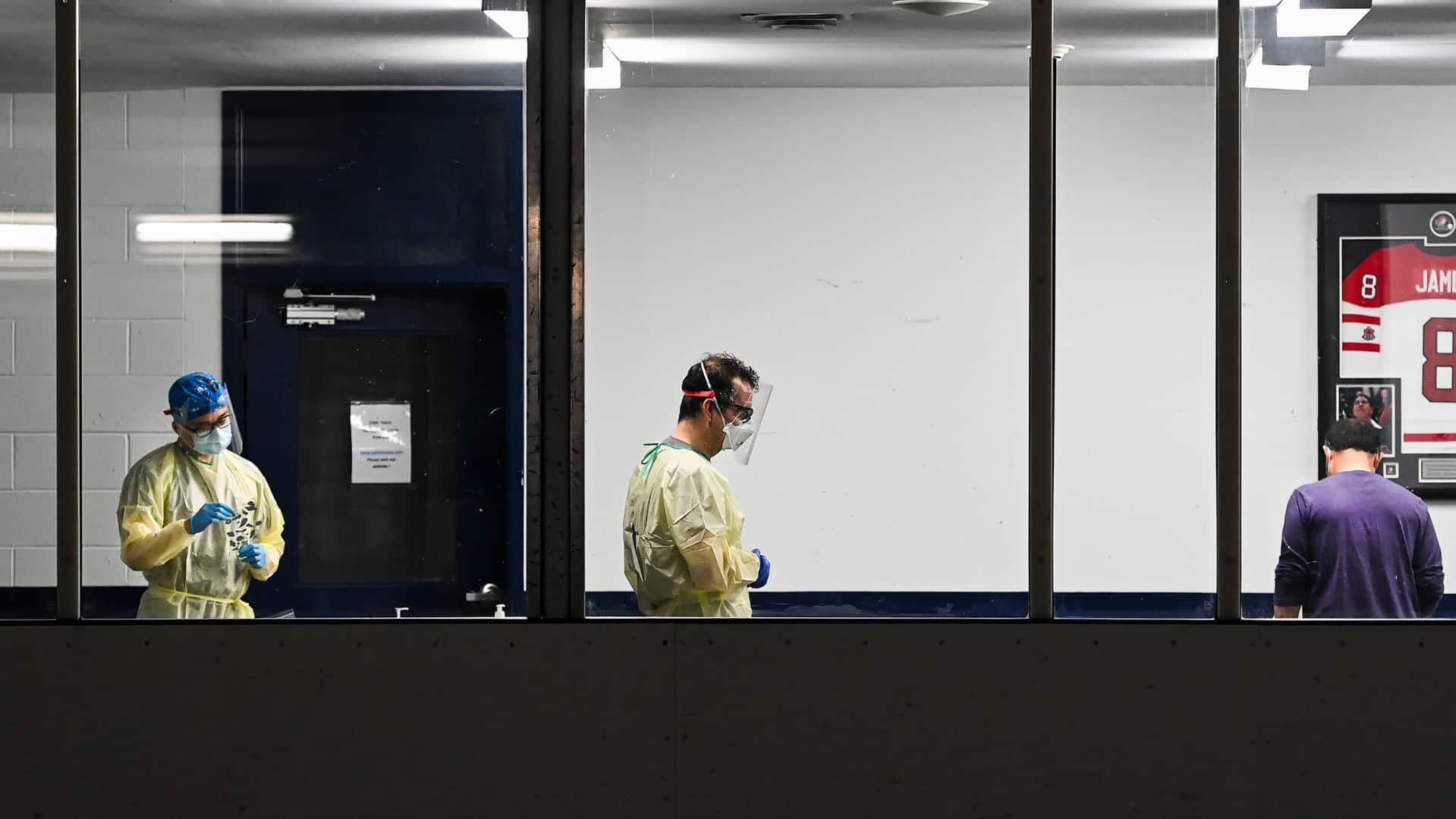Long-term toll on individuals' health remains somewhat uncertain, scientists warn

This story is part of CBC Health's Second Opinion, a weekly analysis of health and medical science news emailed to subscribers on Saturday mornings. If you haven't subscribed yet, you can do that by clicking here.
In the early days of the pandemic, catching COVID-19 felt like a grim game of Russian roulette.
Even young, healthy adults made headlines for ending up in ICUs. Long COVID appeared to strike at random. The virus wreaked havoc in long-term care homes, overwhelmed hospitals and led to a staggering number of deaths.
Fast forward to late 2023, and the situation is dramatically different.
A vast majority of the population has previously caught COVID, and for many, this virus is less of a threat. While hospitalizations linked to COVID are ticking up as winter approaches, they remain at far lower levels than the worst points in the last few years — and cross-country ICU admissions and life-support patients remain relatively stagnant.
There's also hopeful data suggesting rates of long COVID are dropping, while updated vaccines are set to provide a protective boost ahead of another busy respiratory virus season.
It all suggests we've tamed SARS-CoV-2 into submission. Yet this virus continues to circulate year-round, causing repeat infections, with few official measures still in place to curb its spread. Scientists warn the long-term toll on individuals' health remains somewhat uncertain.
"We're moving to a world where we're being asked to manage our own risk, so we should know what that risk is," said epidemiologist Caroline Colijn, a Canada 150 Research Chair in Mathematics for Evolution, Infection and Public Health at Simon Fraser University.
"And it's two things: The risk of getting infected and the risk of a bad thing happening to you if you get infected."
Risks now 'lowest' since pandemic began
Around the world, scientists are striving to parse out just how risky individual COVID infections are at this point in time, though the population-level trends remain reassuring, multiple medical experts told CBC News.
It's at a transition point, said epidemiologist Bill Hanage, with the Harvard T.H. Chan School of Public Health, as we're heading toward a time when COVID becomes more of a background condition, without the same kind of "disturbing, wild fluctuations."
"That is not the same thing as it going away," Hanage said. "That's not the same thing as having no consequences."
But over the course of the last few years, the immunity landscape has shifted, given high rates of previous infections and multiple rounds of vaccinations.
That's led to a significant change in the severity of acute illness, said Dr. Lynora Saxinger, an infectious disease specialist with the University of Alberta. "The burden went from, at times, having most of the medical beds in a hospital filled with COVID patients to, sometimes, not having any COVID patients … or at the most, a handful," she said.
At an individual level, she added, "the risks are the lowest they've been since the start of the pandemic."
For a majority of the population, Hanage echoed, the possibility of a life-threatening infection is now much smaller.
"For older people, especially unvaccinated older people, and especially people in nursing homes, it's still pretty high," he said. "But that's not surprising."
Regardless of someone's age or health status, it's clear that catchingthis virus remains rather easy. Reinfections are the norm, in line with other seasonal coronaviruses.

"We do know that protection against infection wanes, and people can get it multiple times. And on average, people are getting it much more frequently than we get flu," Colijn noted.
"If this virus carries the same long-term risk as flu, but we get it 10 times more often, that risk is going to build.… And it's not like influenza's great and fine. It's deadly and causes serious illness."
Scientists are hopeful the latest COVID vaccines, updated to better match circulating strains of the virus, may help curb transmission in the months ahead. Yet research suggests even prior vaccination or infection won't be enough to combat the virus's potent ability to infect people in closed settings.
One study looking at residents within a U.S. prison system found hybrid immunity, from both previous infection and vaccination, offered the highest level of protection — around 76 per cent — during the Omicron wave in cases where subjects didn't have any known exposure to the virus.
However, when subjects were directly exposed to high levels of SARS-CoV-2, in cases where their direct cellmate was COVID-positive, that level of protection against infection dropped to just 20 per cent.
Lopsided impact on the elderly
Any time people face another bout of COVID, research shows the health impact depends on a variety of factors.
A pre-print study out of the U.K. suggests the risk of getting reinfected shot up substantially after the highly contagious Omicron family of subvariants emerged, but the severity of those subsequent infections is typically lower.
That doesn't mean there's "zero chance" of someone experiencing more serious health impacts, noted Colijn.
COVID's lopsided impact on the elderly, for instance, is well documented. Seniors remain far more likely to suffer serious consequences from an infection, and that risk is heightened in those with multiple pre-existing medical conditions, including health issues that compromise someone's immune system.
One multi-state study from the U.S. Centers for Disease Control and Prevention (CDC) helps quantify those risks. It showed having at least fouror more underlying diseases — such as hypertension, heart disease, chronic obstructive pulmonary disease (COPD) or obesity — puts adults hospitalized with COVID at a higher risk for ICU admission or death, regardless of their vaccination status.
Serious acute illness isn't the only threat. Even for younger, healthier individuals, there is the chance of lingering symptoms after an infection, the potential for worsened mental health issues and an elevated risk of later having a heart attack or stroke.
One study from last year on nearly 200,000 people found getting COVID can hike your chance of developing diabetes as well, with that risk persisting up to a year after infection, even in cases of mild illness.

Researchers who analyzed a massive database of U.S. veterans' health records have tried to tease out the risks of COVID infections and reinfections on individuals' longer term health.
Recently, the team found a dramatically increased risk of dozens of conditions — including fatigue and heart failure — lasting, at times, years after an infection, with higher rates among those hospitalized.
Using the same dataset, the researchers also previously explored reinfection risks, suggesting people getting COVID a second time are at a higher risk of serious outcomes.
But many outside scientists say the headline-making papers have major limitations.
The veterans in the study were overwhelmingly white, male and in their 60s, on average, so the findings don't necessarily apply beyond that population. And some scientists say the findings linked to reinfections didn't actually show direct causation, and don't line up with other data suggesting lower rates of severe illness among patients who've been previously infected.
Colijn agreed the group being studied isn't representative of the broader population and stressed the findings are from an earlier point in time.
The research also doesn't capture the high number of infections that may be flying under the radar, she said, when people have mild or no symptoms, and never get tested — meaning the cases with serious long-term impacts could be a smaller amount of a bigger total.
Still, she said, "I don't think the fact that it's imperfect means we throw it away."
WATCH | Updated COVID-19 vaccines rolling out this fall:
.jpg?crop=1.777xh:h;*,*&downsize=510px:*510w)
Wait for updated COVID-19 booster this fall, experts suggest
Despite an expected fall wave of COVID-19, health experts recommend most people wait for the next, updated vaccine — still a few weeks away — to get a booster for the most protection.
Lives 'destroyed' by long COVID
Exact rates of long COVID, specifically, remain one of the most elusive data points. Officially known as Post-COVID Conditions, or PCC, the term refers to a broad spectrum of health issues that can arise following an acute COVID infection.
The definition captures various time points — lasting weeks, or months, or years — and a wide variety of symptoms, from temporary changes in someone's menstrual cycle or lingering changes in someone's sense of taste and smell, all the way to debilitating, persistent health impacts such as difficulty breathing, extreme fatigue or brain fog.
Early in the pandemic, prior to vaccines, long COVID appeared to strike at random, with early figures suggesting anywhere from 10 to 40 per cent of people could be affected.
Now a clearer picture is emerging. Many scientists agree there were likely lower rates of lasting health impacts than previously thought, while the estimated percentage of people acquiring some form of long COVID also appeared to drop.
"Most of the data does seem to suggest that vaccination or prior COVID can, more or less, reduce your risk of long COVID," said virologist Angela Rasmussen, from the University of Saskatchewan's Vaccine and Infectious Disease Organization.
"But we can't even really define long COVID effectively — and long COVID is probably more than one thing. It's going to affect people and their quality of life in different ways."
One study from a Swedish research team found 1.3 per cent of individuals infected by an early strain of SARS-CoV-2 were later diagnosed with long COVID, and that percentage dropped during each major wave of subsequent variants. By the Omicron cohort — the family of subvariants still circulating — only 0.2 per cent of people were diagnosed with long COVID.
The findings were consistent across all the groups being studied, with one important caveat: There was no difference between each wave among people being treated for COVID in ICUs, suggesting those battling severe disease still run the risk of long-lasting health issues.

Also, even a small percentage of long COVID among a vast number of infections adds up to many people suffering lasting health impacts.
A recent paper in the British Medical Journal, sharing accounts of doctors' lives "destroyed" by their illness, noted that nearly five per cent of U.K. health-care workers have acquired some form of long COVID, while surveys suggest 18 per cent of those suffering may no longer be able to work.
"Long [COVID] has completely upended my life," one doctor told the journal.
WATCH | Most long COVID symptoms resolve within a year, study suggests:

Most long COVID symptoms clear up within a year, new research suggests
New research out of Israel suggests most symptoms of long COVID clear up within a year, but some — like weakness and trouble breathing — are more likely to persist.
'It does have consequences'
So what are the takeaways for people trying to navigate a world where COVID is subdued, yet ever-present?
"For the average person wondering, 'How much should I need to panic? Some voices are saying the sky's falling, others are saying, nah, don't worry about it,'" Saxinger said. "The truth is somewhere in the middle."
Rasmussen agreed there's a mental balancing act at play. For most people, she said, there's no sense living in fear of COVID, or assuming that your next infection will be deadly or life-altering.
"But it is [about] acknowledging that COVID is not just a cold, it's not harmless for many people, and it does have consequences," she said. "And we don't know what all of those consequences are."
Basic precautions put in place throughout the pandemic to maintain hospital capacity can still play a role in reducing individual risk, medical experts agree. That can mean getting an updated COVID shot, wearing an N95 mask in closed settings where the risk of transmission is higher, and implementing methods to better clean indoor air.
Yet even our best collective efforts won't stamp this virus out, Rasmussen said.
"In terms of SARS-CoV-2 in the viral landscape — it's a permanent part of it," she said. "And whether people like that or not, that's the reality."

Add some “good” to your morning and evening.
A variety of newsletters you'll love, delivered straight to you.
*****
Credit belongs to : www.cbc.ca
 MaharlikaNews | Canada Leading Online Filipino Newspaper Portal The No. 1 most engaged information website for Filipino – Canadian in Canada. MaharlikaNews.com received almost a quarter a million visitors in 2020.
MaharlikaNews | Canada Leading Online Filipino Newspaper Portal The No. 1 most engaged information website for Filipino – Canadian in Canada. MaharlikaNews.com received almost a quarter a million visitors in 2020.







